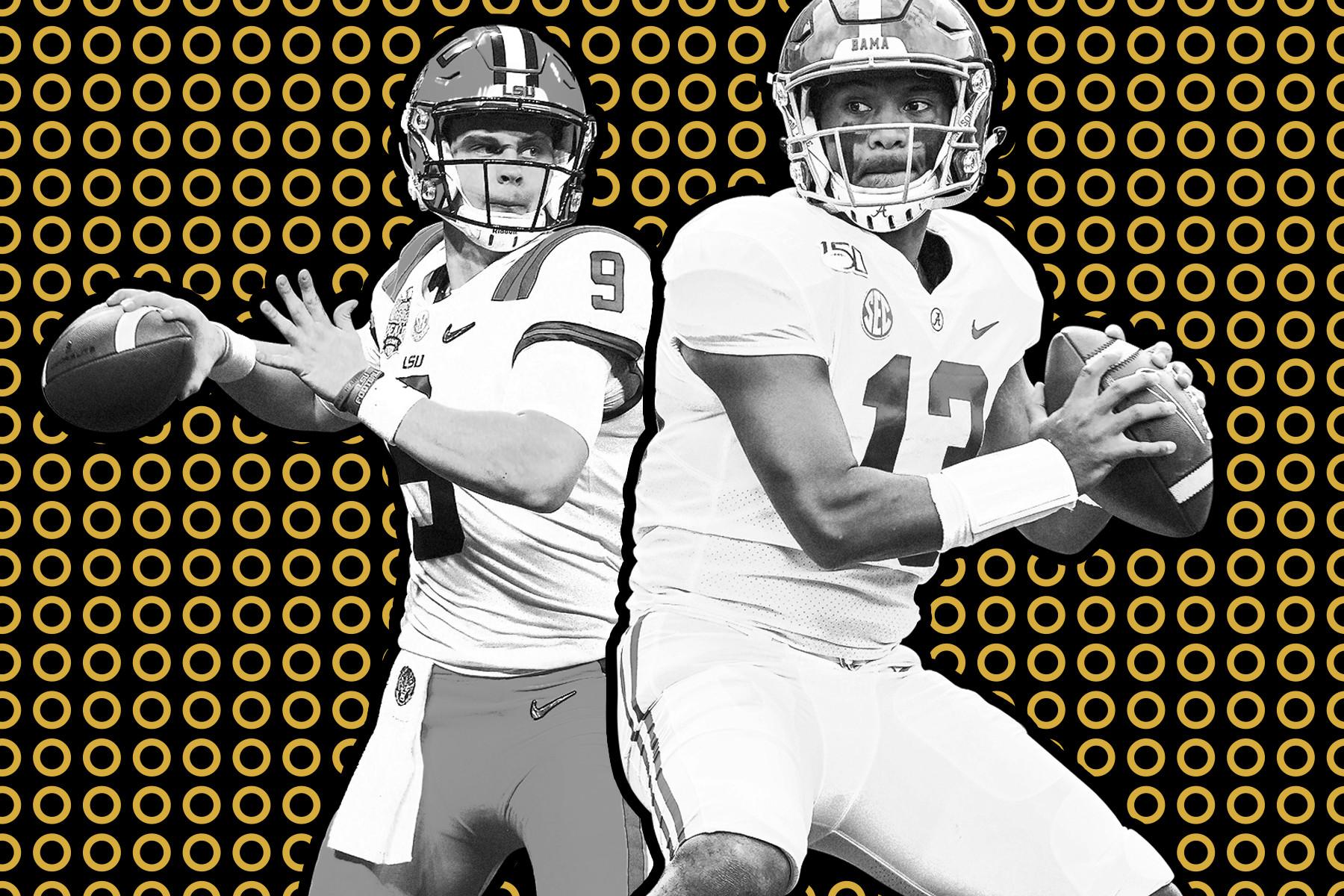For the first time in NFL history, there are more than enough quarterbacks to go around. Every organization has its preferred passer, so teams are focusing on pass catchers instead. Six receivers were taken in the first 25 picks on Thursday, the most since the NFL merger in 1970, and a sign that this is the deepest receiver class in recent memory. But for all the obsessing over rankings and big boards, NFL success depends on context just as much as raw talent. Here is how the receivers from a historic first round fit with their new teams.
Las Vegas Raiders (No. 12)
The Pick: Henry Ruggs III, Alabama
You can take the Raiders out of Oakland (and Los Angeles, and Oakland again) but you can’t take Al Davis out of the Raiders. The late longtime owner was obsessed with speed, and his son Mark’s team is carrying on that principle by drafting Ruggs, the fastest man in this year’s class. Ruggs ran a 4.27-second 40-yard dash at the combine, faster than the 4.30 that Darrius Heyward-Bey ran that convinced the Raiders to make him the first receiver off the board in 2009. Ruggs had just 98 catches in three years at Alabama, but almost a quarter of those receptions went for touchdowns (24). In terms of fitting the historical profile of what the front office deems a Raida, there is no better fit in the entire draft. But how Ruggs meshes with this current Raiders team is dubious.
Nasty speed is increasingly an asset in the NFL, from Tyreek Hill in Kansas City to Will Fuller V in Houston to DeSean Jackson in Philadelphia to Marquise Brown in Baltimore. But those players mostly serve as Robin to someone else’s Batman rather than being the main option themselves. The teams that have burners who can stretch the field are opening huge gaps underneath and shredding the middle of the field, but the Raiders don’t have the kind of talent necessary to do either of those things. Tight end Darren Waller had a stellar season, but the Raiders’ main incumbent receivers are slot man Hunter Renfrow and fellow speedster Tyrell Williams. There is little doubt that Ruggs can be an NFL starter, but he might not be the no. 1 receiver quarterback Derek Carr needs. Last year, Carr tied with Jimmy Garoppolo for the second-shortest average pass attempt length, so expect the Raiders, at a minimum, to start chucking the ball farther downfield than they did last year.
Denver Broncos (No. 15)
The Pick: Jerry Jeudy, Alabama
Everyone in reach of the Rockies knew the Broncos were looking for a wide receiver in this draft, but it seemed like an outside chance that either Oklahoma’s CeeDee Lamb or Alabama’s Jerry Jeudy, the two consensus top receivers in this class, would still be there when Denver picked at no. 15. Instead, both were on the board. Broncos president John Elway elected to take Jeudy, the Alabama star who was the most polished receiver in college football last season. The hope is that he can become the next Amari Cooper or Julio Jones, two other Alabama receivers who became elite pros. Jeudy is the only receiver in this class who has a grasp on the entire route tree, from short to intermediate to deep, and he’ll be an excellent fit in Denver, which quietly has a lot of young talent on offense. Quarterback Drew Lock, receiver Courtland Sutton, tight end Noah Fant, and tackle Dalton Risner were all added in the past three years. The Broncos are four years into their post-Peyton quarterback odyssey, from Brock Osweiler to Trevor Siemian to Paxton Lynch to Joe Flacco to Lock. We don’t know yet whether Lock is the Guy in Denver, but adding Jeudy to this team gives him an excellent supporting cast to prove himself.
Dallas Cowboys (No. 17)
The Pick: CeeDee Lamb, Oklahoma
Lamb is already known to Texas college football fans as the man who haunts their dreams.
Now the Oklahoma star can cross the Red River and be welcomed into Texas as a hero, which would have been the upset of the first round if the Packers hadn’t decided to antagonize Aaron Rodgers. The receiver many analysts pegged as the best in a loaded class ended up being the third taken off the board, helping Jerry Jones complete his quest to round out his pass-catching corps.
The Cowboys went into 2018 with Allen Hurns, Cole Beasley, Terrance Williams, Deonte Thompson, and Tavon Austin at receiver. Now they have Amari Cooper, Michael Gallup, and CeeDee Lamb. A team that had perhaps the weakest pass-catching group in the league two years ago now boasts one of the strongest. Dallas just made Cooper the second-highest-paid receiver in the NFL at $20 million annually and will likely make Dak Prescott the highest-paid player in league history later this year, and adding Lamb will make both of their jobs easier. This is the best fit of any rookie receiver, and perhaps the best fit of any non-quarterback in the entire first round. Lamb does not transform the Cowboys offense, but he may complete it. (Considering how much Dallas has invested on offense in money and draft picks, he’d better.) The cherry on top—Dallas took him away from Philadelphia.
Philadelphia Eagles (No. 21)
The Pick: Jalen Reagor, TCU
Eagles fans can say whatever they want, but we all know they are pissed. Philly fans were scarred last season when the Eagles fielded one of the most injury-riddled offenses in recent history. They were so depleted that Greg Ward, a former AAF receiver, became their most reliable player. Adding insult to injury, the receiver Philadelphia drafted in the second round over D.K. Metcalf last year, Stanford’s J.J. Arcega-Whiteside, could barely get playing time against Metcalf and the Seahawks in the wild-card round despite Eagles receivers dropping like flies. Even worse, Metcalf had seven catches for 160 yards and a touchdown against the Eagles in that game—almost the same totals as Arcega-Whiteside (10 catches, 169 yards, and 1 touchdown) had all season.
Eagles fans entered this draft desperately wanting a receiver and keenly aware of their front office’s dubious ability to draft them (here are the receivers Philadelphia has drafted since 2010: Riley Cooper, Marvin McNutt, Jordan Matthews, Josh Huff, Nelson Agholor, Mack Hollins, Shelton Gibson, and Arcega-Whiteside). So when rumors emerged that GM Howie Roseman was trying to trade up to acquire Lamb, the top prospect, the news thoroughly excited Eagles fans. Not only did Philly not trade up to get Lamb, but Lamb went to its biggest rival while the Eagles settled for Reagor.
“We’re very aggressive in working the phones and having these conversations with teams and trying to figure out where we can move and when we can move,” Roseman told reporters after the draft. “[A trade] just has to work for both sides obviously, but we are also very comfortable sitting here and taking a player that has a great skill set for what we’re looking for. Like Coach [Pederson] just said, we knew there were a lot of talented receivers in this offense and there is a lot of different flavors, and this was the one we felt could really help our football team in multiple ways.”
Reagor was a solid player at TCU and would have been considered a steal by some had he gone in the middle of the second round. But the reality is he may always be viewed by Eagles fans in comparison to Lamb. Luckily, all Reagor may have to do to get Eagles fans to love him is stay on the field and catch the ball—unlike Agholor.
Minnesota Vikings (No. 22)
The Pick: Justin Jefferson, LSU
Four touchdowns is a good month for most players. Jefferson had four scores in the first half of LSU’s College Football Playoff game against Oklahoma. This is what Vikings fans will be watching on a loop until sports come back.
That game showed Jefferson’s ability to dominate, but Vikings general manager Rick Spielman and head coach Mike Zimmer are also betting on his versatility. The team dealt Stefon Diggs to Buffalo last month, then used that pick to draft Jefferson, making him the obvious replacement. But Jefferson mostly played out of the slot at LSU, so it will be interesting to see where he plays in Minnesota alongside Adam Thielen. Thielen played in the slot for just a third of his snaps amid an injury-riddled 2019 campaign in which he had just 418 yards in 10 games. But Thielen spent more than half of his field time in the slot in his breakout 2017 season and stellar 2018 season, so Minnesota is likely predicting that Jefferson can spend at least half of his snaps on the outside. Diggs ranked second in the NFL in yards per route run last season, only behind New Orleans’ Michael Thomas, so Jefferson has some efficient footsteps to follow. His upside might be higher than that of Diggs himself, but the Vikings boast a win-now roster that needs Jefferson to be productive sooner rather than later.
San Francisco 49ers (No. 25)
The Pick: Brandon Aiyuk, Arizona State
San Francisco receiver Emmanuel Sanders nearly won the 49ers the Super Bowl in February, but Garoppolo’s pass sailed just a few yards too long and the 49ers lost (which may have been a good thing for the sake of humanity). Sanders is just one of three starters not returning to the 49ers this season, but the team is hoping it found his replacement in Aiyuk (pronounced eye-yook). San Francisco dealt the 31st, 117th, and 176th pick to Minnesota to select him with the 25th pick, and head coach Kyle Shanahan said Aiyuk was one of the top two receivers on the Niners’ draft board.
“He was my favorite receiver I evaluated,” Shanahan claimed after the first round, according to The Athletic. “There’s no doubt about it. Lamb … was the guy who was in competition with him.”
The fit does make sense given the 49ers’ offensive philosophy. For all of the complexities around Shanahan’s passing game, the whole system boils down to three simple steps:
- Confuse the defense about where the ball is
- Use that confusion to get someone wide open
- Let that person run with the ball in space
If football is so simple, why doesn’t every team do that? Shanahan’s 49ers are different because they create big plays with short passes. Garoppolo’s average pass last year traveled just 6.6 yards in the air, tied with Carr for the second-shortest among qualifying QBs. But the 49ers averaged 5.9 yards after the catch, the most in the NFL. So despite rarely tossing the ball downfield, the 49ers had the second-most passing yards per attempt and tied for the fourth-most plays of 20-plus yards. Just like Hemingway knew big emotions don’t come from big words, Shanahan knows long plays don’t need to come from long passes.
Since Shanahan schemes big plays with short passes to players who are wide open, the ideal 49ers pass catchers are athletes who are exceptional with the ball in their hands. It is not a coincidence the franchise has the untacklable tight end George Kittle, jacked receiver Deebo Samuel, and the fastest running backs group in the NFL. Aiyuk played running back in high school before switching to wide receiver in college, and he averaged 13.6 yards after the catch last season at Arizona State, so he’s the kind of player who could thrive in this scheme. Maybe he can take a short pass to the end zone if the 49ers make it back to the Super Bowl rather than Garoppolo overthrowing another deep shot.

